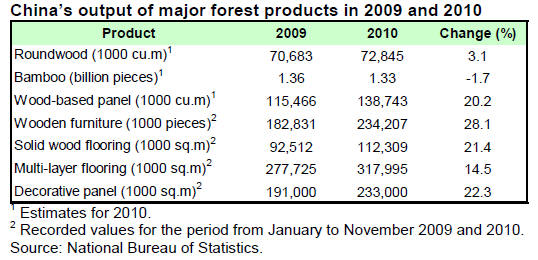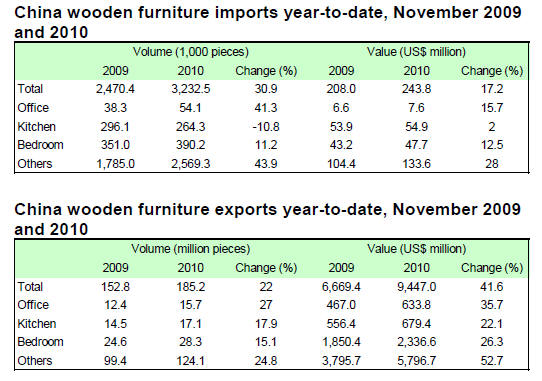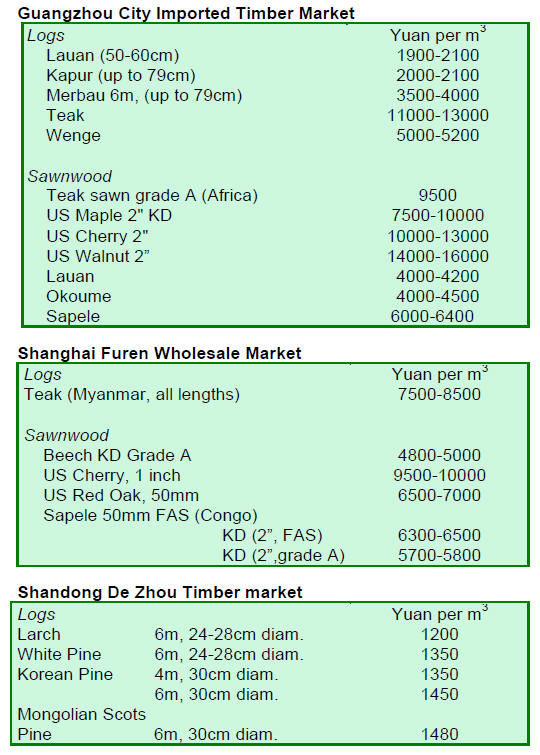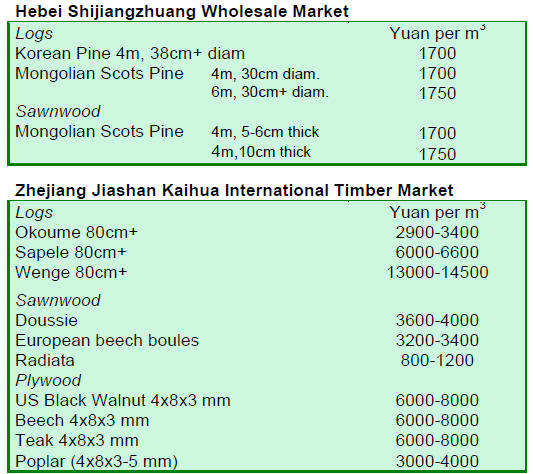US Dollar Exchange Rates of 15th
Feb 2011
China Yuan 6.5892
Report from China
Total forest industry output surpasses RMB 2,000
billion in 2010
According to the National Bureau of Statistics, the total
value of forest industry output in 2010 in China is
estimated to have reached RMB 2,090 billion, up 20%
over 2009.
Of the total output value, 37.8% or RMB790.1 billion is
estimated to have come from primary forest industry
(mainly non-wood forest products). The secondary forest
industry (mainly SPWPs and bamboo products) accounts
for 53.2% of the total output value at RMB1,112.3 billion.
Tertiary forest industry (mainly tourism and recreation)
accounts for 9.0% of the total with RMB188.9 billion.
Compared to 2009, the production of wood processing
industry (enterprises with annual sales over RMB 5
million) in 2010 surged 22.2%, while those of furniture
industry and the paper and paper products industry
increased by 19.5% and 16.2% respectively.
According to the estimates, the production of roundwood
in 2010 is expected to reach 72.84 million cu.m, up 3.1%
compared to 2009. The output of bamboo is estimated at
1.33 billion pieces, almost the same as in 2009. The
production of wood-based panels is expected to reach
138.74 million cu.m, 20.2% higher than in 2009.
According to the National Bureau of Statistics, the
accumulated output of wooden furniture from January to
November amounted to 234 million pieces, up 28.1% over
the same period in 2009, while the output of solid wood
flooring was 112 million square metres (+21.4%), multilayer
flooring 318 million square metres (+14.5%),
decorative panel 233 million square metres (+22.3%).

China’s wooden furniture trade soars
China is the largest wooden furniture producing and
exporting country, with the main export destinations being
Europe, the US and Japan. Due to the global economic
crisis, China’s exports of wooden furniture declined in
2008 but recovered in 2009. According to the statistics, the
period from January to November 2010 showed robust
growth in China’s wooden furniture trade.
The value of wooden furniture imports in China totalled
US$244 million from January to November 2010, a
significant jump of 17% compared to the same period in
2009. Even so, China exported much more wooden
furniture (excluding wooden framed seats) valued at
US$9,447 million year-to-date November 2010, 42%
higher than in the same period in 2009.

Rapid development of the eucalyptus industry in China
Due to increasing demand for timber, the eucalyptus
plantation industry has undergone rapid development in
China in recent years. The area of eucalyptus plantations
has increased from 1.7 million hectares in 2006 to 3.13
million hectares in 2010.
The rapid expansion of eucalyptus plantations has
contributed to the development of the pulp and paper
industry in China. A large number of wood pulp mills
have been established in recent years. The technologies to
produce pulp from eucalyptus have improved and at the
same time the prices of eucalyptus have almost doubled.
The eucalyptus industry has thus played an important role
in poverty reduction in rural areas of China.
SFA sets forestry sector development goals by 2015
The Twelfth Five Year Plan for the Forestry developed by
the State Forest Administration (SFA), defines the
development goals of forestry in China by 2015 as
follows:
• Expanding the forest cover by 21.66%;
• Expanding the forestry land area to 309 million
hectares;
• Increasing the growing stock of forests to 14,300
million cu.m;
• Increasing the forest carbon stock to 8,400 million
tonnes;
• Increasing the total output value of forestry to RMB
3,500 billion by 2015.
In addition, the Five Year Plan is to educate people’s
awareness of ecological protection.
Reduced harvests in Daxinganling Forest Area
It is reported that the total harvest volume in Daxinganling
Forest Area of Heilongjiang Province in 2010 was 650,000
cu.m less compared to 2009. From 2006 to 2009, the total
reduction in harvests amounted to 2.68 million cu.m.
The Daxinganling Forest Management Bureau has formed
9 inspection teams which were able to detect 19 cases of
illegal logging and 19 cases of deforestation in the area. In
addition, 4.5 hectares have been illegally converted into
agriculture.


|